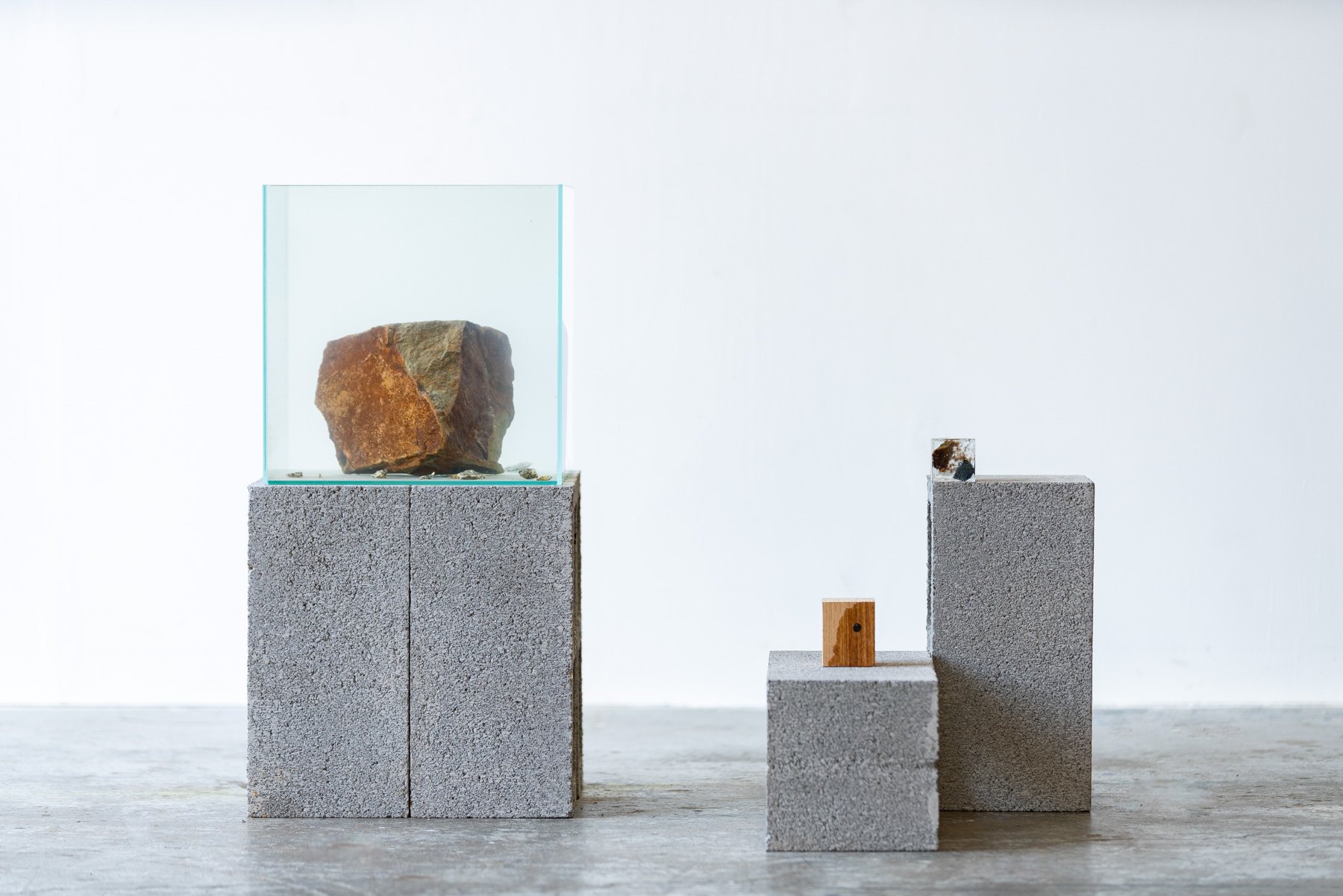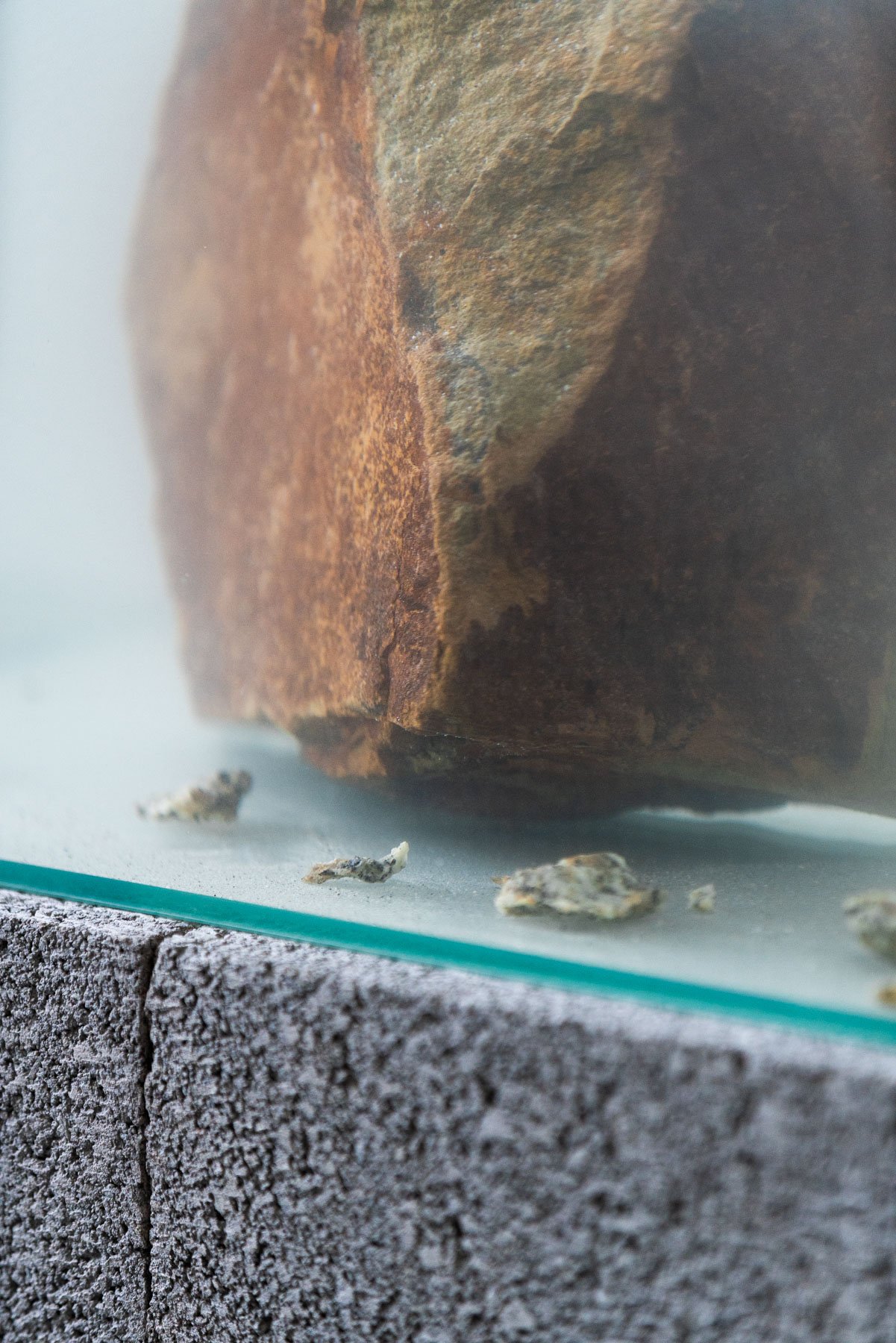Becoming, 2023
Becoming, 2023
Alex Lark
granite, sandstone, basalt, wood, glass, water, resin, cinderblock,
220cm x 100cm x 70cm
photos: courtesy of the artist
Becoming, 2023
Alex Lark
granite, sandstone, basalt, wood, glass, water, resin, cinderblock
220cm x 100cm x 70cm
Moorabbin, Narrm (Melbourne)
Sandstone sourced from Yapeen and Harcourt granite shards and dust sourced from Mt Alexander submerged in water from Dandenong Catchment sourced from tap encased in glass atop concrete mason blocks.
50 x 50cm x 100cm
Detail of Harcourt granite shards and dust sourced from Mt Alexander. The shards and dust were drilled and collected from the core of a granite boulder by the artist at Pyrenees Quarry, Castlemaine on Dja Dja Wurrung lands.
Sandstone shard, basalt shard and Victoria Ash sawdust cast in resin.
5cm x 5cm x 5cm
Sandstone shard, basalt shard and Victoria Ash sawdust cast in resin.
5cm x 5cm x 5cm
Detail of sandstone sourced from Yapeen shard, basalt shard, Victoria Ash sawdust collected from core and air bubbles cast in resin.
Sandstone shard, basalt shard and Victoria Ash sawdust cast in resin.
5cm x 5cm x 5cm
Detail of sandstone sourced from Yapeen shard, basalt shard, Victoria Ash sawdust collected from core and air bubbles cast in resin.
Victoria Ash hardwood, basalt rock, resin.
5cm x 5cm x 7cm
Victoria Ash sawdust from core of hardwood.
Sandstone shard broken from sandstone boulder
Detail of basalt rock shards suspended in resin within a circular cavity of Victoria Ash hardwood
Statement about the work
Alex Lark, June 10th 2023
What does it mean to become? Is it possible to put your finger on the moment from when you were to what you’re beginning to be? This identity of the individual is in a state of constant change. A ceaseless flow of experience piercing the membrane of our internal being. It hardens the resolve of our innate sense of self and reinforces the idea of who we are by what we have known. This known, this constellation of moments that have come before now, is fundamental to our comprehension of ourselves. Our memory is intrinsic to tallying the vivaciousness of our existence. It’s the chalk lines in our mind that mark the pleasure, pain, suffering and joy. An electrical, chemical and fleshy entity filling with the experiences born through the endurance of life. Each living thing absorbs some part of the refraction and echo surrounding it. Each thing becomes part of the other as an endless exchange of memory and experience.
“It’s the chalk lines in our mind that mark the pleasure, pain, suffering and joy.”
Memory is a trace of existence. It permeates through everything: the air you inhale while reading, the heat coming off your shoulders, the water moving over your fingers as you wash your hands. The objects and elements in your daily life remember you as much as you remember them, perhaps even more so. The lives of the things around you have an animism(1) about them. The cup on your desk has a soul as does the rock in your garden. An essence is carried through time as memory. But where is this memory held? What are the boundaries of its physicality? Is it like the ancients believed from the “Latin root of the word recŏrdari, ‘to remember’, mean[ing] ‘putting back (re) in the heart (cor, cordis)”(2) that it rests in our beating chest? Or is it like modern Western society's belief that it is held in the brain? Surely memory exists beyond a singular organ but is it a confined sum within our cells and atoms?
“The objects and elements in your daily life remember you as much as you remember them, perhaps even more so.”
These questions crashed over me recently as I killed a granite stone. I know that is not possible but at the same time, it is the reality I felt. The drill plunged into the heart of the rock as shards and dust poured from within. I saw the rock and knew I had done more than insult it (3) with a void through its core. However, collecting the displaced pieces of granite the supposed death felt shortsighted. As Nobuo Sekine has said “The universe exists in a constant state of being, neither losing nor gaining matter. Therefore one cannot really create; one can only expose what is there”(4) and there now existed a new equation with the same sum total. This transference of form posed new questions. Can a stone be envious of its own particles as they fly away as it lays rooted to the earth? Or does the dust envy the steady, grounding nature of its previous form?
“The universe exists in a constant state of being, neither losing nor gaining matter. Therefore one cannot really create; one can only expose what is there.”
These intrinsic virtues, the cell memories(5) of self and object, are whole even when divided. Embracing the mathematical concept of phase, “specifically the properties that are preserved under continuous deformations... form, matter, and space as infinitely malleable”(6), a splintering from their “original” is not a reduction, simply a transference. The complication is in this process, not because it is complex, but because of our need to understand and label. In the transition, we seek to hold the identity of what was before. It is difficult to perceive the new as wholly new. It is a derivative and divinely unique, of many and of one.
The breeze that inhales the dust now contains “different existential dimensions but also different forms of self-representation”(7). The breeze is stone and the breeze is water. The breeze is the memory of the drill and the heat of its power. It is the dirt and the sawdust. It is the endless experience of all pieces and particles that have been carried before and all that will be carried ahead. Each thing is a living monument to another - an intrinsically interwoven fabric of memory through everything constantly transmitting traits from one individual to another.(8) We can perceive you and I as separate and individually distinct from a narrow time frame reference. But from an immensely wider view, one of deep time over millennia, the transference of particles and cells is guaranteed. We are the same. Right now we are simply in a state of becoming.
-
R.D. Holmboe, “Lee Ufan, the Hidden Face of the Moon,” Third Text 34, no. 2 (March 3, 2020): pg. 300, doi:10.1080/09528822.2020.1739875.
Sara Damiani, “Monuments of the Heart: Living Tombs and Organic Memories inContemporary Culture,” In Bodies of Stone in the Media, Visual Culture and the Arts, ed. Alessandra Violi, Barbara Grespi, Andrea Pinotti, Pietro Conte (Amsterdam: Amsterdam University Press, 2020), 343, https:// www.jstor.org/stable/j.ctv12sdvn4.27.
Ted Loos, “Squeezing essence from a stone,” The New York Times, June 26, 2011. link.gale.com/apps/ doc/A259776072/AONE?u=unimelb&sid=bookmark-AONE&xid=8e062be2.
Ashley Rawlings, “Turning the world inside out: a major survey of Mono-ha in Los Angeles,” Art and Australia 49, no.4 (2012): 583, https://search.informit.org/documentSummary;res=IELAPA;dn=201206458.
Damiani, “Monuments of the Heart,” 350.
Blum & Poe, “Nobuo Sekine,” Blum & Poe press release, January 11, 2014. Nobuo Sekine. http:// www.nobuosekine.com/nobuo-sekine-3/.
Damiani, “Monuments of the Heart,” 356. 8 Damiani, “Monuments of the Heart,” 349.
-
Blum & Poe. “Nobuo Sekine.” Blum & Poe press release, January 11, 2014. Nobuo Sekine. http://www.nobuosekine.com/nobuo-sekine-3/, accessed May 28, 2023.
Damiani, Sara. “Monuments of the Heart: Living Tombs and Organic Memories in Contemporary Culture.” In Bodies of Stone in the Media, Visual Culture and the Arts, edited by Alessandra Violi, Barbara Grespi, Andrea Pinotti, Pietro Conte, 343-359. Amsterdam: Amsterdam University Press, 2020, https://www.jstor.org/stable/j.ctv12sdvn4.27.
Holmboe, R.D. “Lee Ufan, the Hidden Face of the Moon.” Third Text 34, no. 2 (March 3, 2020): 291–310. doi:10.1080/09528822.2020.1739875.
Loos, Ted. “Squeezing essence from a stone.” The New York Times, June 26, 2011. link.gale.com/apps/doc/A259776072/AONE?u=unimelb&sid=bookmark-AONE&xid=8e062be2.
Rawlings, Ashley. “Turning the world inside out: a major survey of Mono-ha in Los Angeles.” Art and Australia 49, no.4 (2012): 580-583. https://search.informit.org/ documentSummary;res=IELAPA;dn=201206458.












